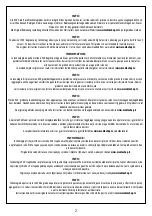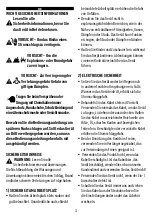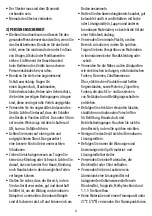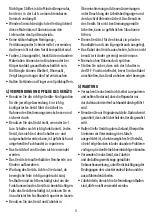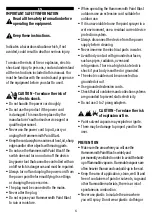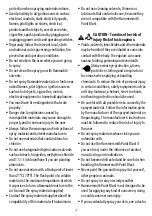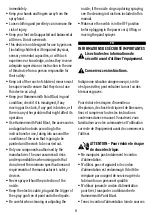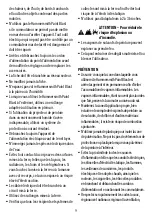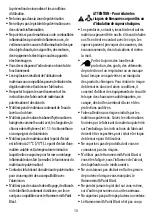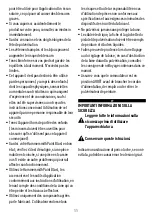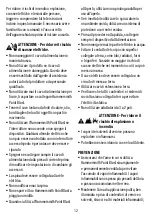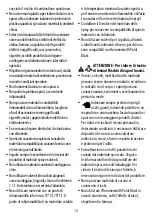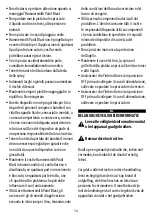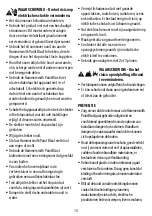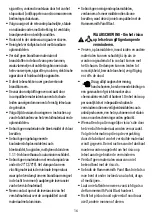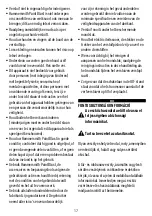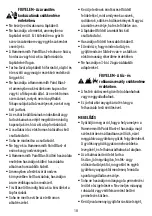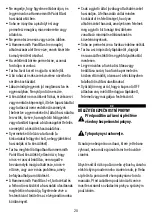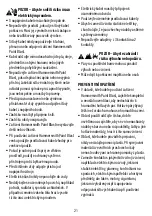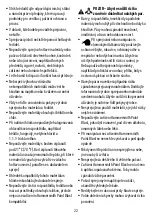
6
7
protection when spraying materials indoors.
• Avoid proximity to all ignition sources such as
electrical conduits, static electricity sparks,
flames, pilot lights on stoves, electrical
products and hot objects; as well as motors,
cigarettes, sparks produced by plugging and
unplugging power cords and operating switches.
• Rigorously follow the relevant local, state
and national codes governing ventilation, fire
prevention and operation conditions.
• Do not smoke in the area where you are going
to spray.
• Do not clean the spray gun with flammable
solvents.
• Do not spray flammable materials or fuels near
naked flames, pilot lights or ignition sources
such as hot objects, cigarettes, motors,
electrical equipment or household appliances.
• You must have fire extinguishers that work
properly.
• Danger due to explosions caused by
incompatible materials may cause damage to
property and/or serious injury to the user.
• Always follow the warnings and instructions of
spray material and solvent manufacturers.
• Do not use materials that contain bleach or
chlorine.
• Do not use halogenated hydrocarbon solvents
such as bleach, fungicides, methylene chloride
and 1.1.1-trichloroethane if you are painting
aluminium.
• Do not use materials with a flash point of lower
than 21°C (70°F). The flash point of a volatile
material is the minimum temperature at which
it vaporises to form a flammable mixture in the
air (consult the spray material supplier)
• Contact the spray material supplier about the
compatibility of this material with aluminium.
• Do not use cleaning solvents, thinners or
lubricants that contain silicone, because they
are not compatible with the Hammersmith
Paint Blast.
CAUTION - To reduce the risk of
injury Risk of toxic vapours.
• Paints, solvents, insecticides and other materials
may be harmful if they are inhaled or come into
contact with the body. The vapours can cause
nausea, fainting, poisoning and even death.
•
Always wear eye protection, gloves,
protective clothing and a respirator or
face mask when spraying or handling
chemicals. To reduce the risk of personal injury
in certain conditions, safety equipment such as
anti-slip footwear, a helmet, steel-toe boots
and hearing protection should be used.
• Be careful with all possible risks caused by the
sprayed material. Follow the information given
by the manufacturer of the sprayed material on
thepackaging. The manufacturer’s instructions
must be followed to reduce the risk of injury to
the user.
• Do not spray materials whose risks you are
unfamiliar with.
• Do not use the Hammersmith Paint Blast if
you are tired, under the influence of alcohol,
narcotic drugs or medications.
• Do not become distracted and be careful when
handling the Hammersmith Paint Blast.
• Never point the gun and/or spray it at yourself,
other people or animals.
• Do not spray in rainy or windy weather.
• Hammersmith Paint Blast is not designed to be
used for applying any kind of sunscreen; doing
so could cause serious injury.
• If you accidentally spray your skin, see a doctor


